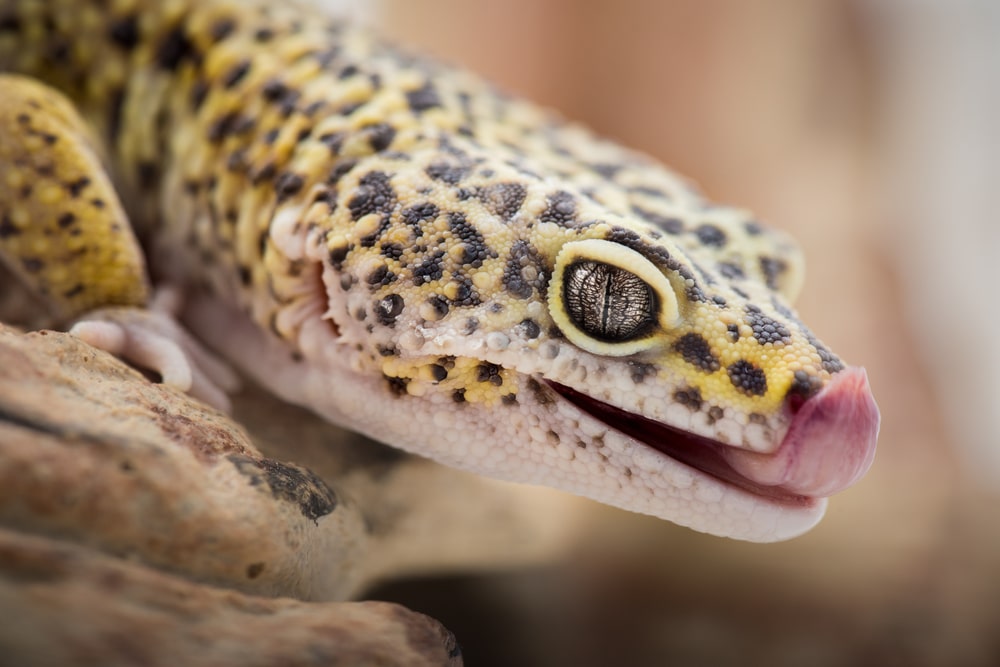Lizards are often the first pet reptile for a lot of folks. They are the closest reptile that looks like a dinosaur and they don’t carry the innate fe
Lizards are often the first pet reptile for a lot of folks. They are the closest reptile that looks like a dinosaur and they don’t carry the innate fear that snakes bring to certain people. Lizards can make great display animals and depending on the species, can be regularly handled. Here we present to you five great friendly lizards in no particular order.
Bearded Dragon
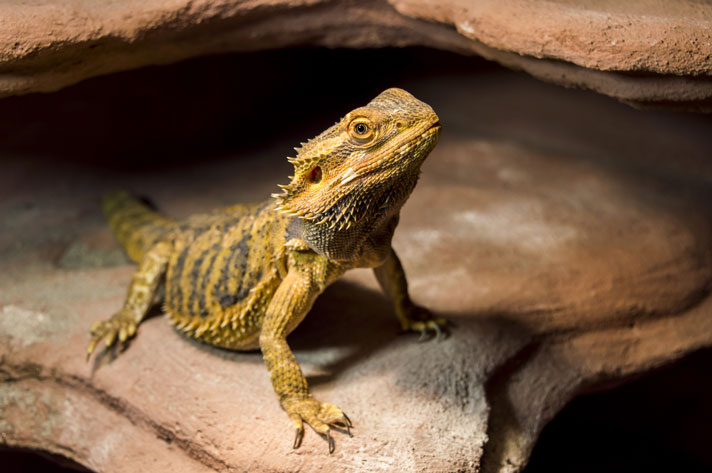
Robert Keresztes/shutterstock
Beardies are widely captive bred and their care requirements are easily established given the right information.
The bearded dragon (Pogona vitticeps) along with the leopard gecko, shares the top spot in the pet lizard kingdom. The beardie is probably the more popular of the two by virtue of it having more of a personality than the leopard gecko. Beardies are widely captive bred and their care requirements, while more than that of a leopard gecko are easily established given the right information. Pogona vitticeps comes from very hot regions of Australia and like it hot. Give them a basking site of around 100 degrees Fahrenheit at one end of the enclosure while the other end stays relatively cooler. Speaking of enclosures, give them a minimum 75-gallon or equal sized enclosure with full spectrum UVB lighting. Beardies eat insects and plant material and are usually very hardy feeders. They are also available in a variety of color morphs as well. For more information on this lizard for intermediate to advanced keepers, visit the Bearded Dragon Care Sheet here.
Gold-Dust Day Gecko
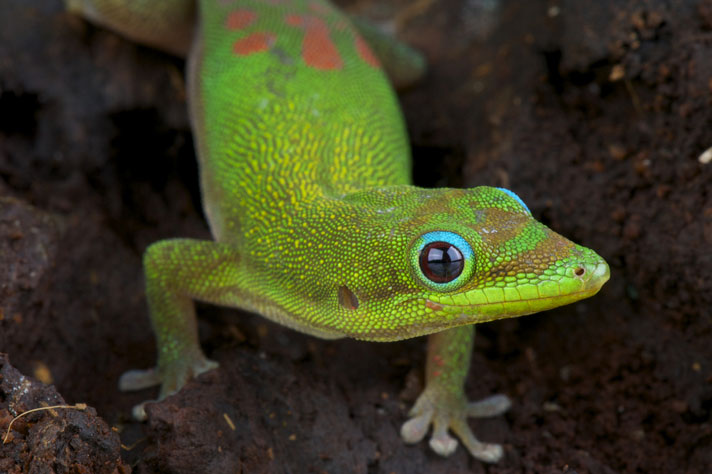
reptiles4al/shutterstock
The gold dust day gecko is one of the most beautiful lizards.
The gold-dust day gecko (Phelsuma laticauda) in my opinion is one of the most beautiful lizards. Native to Madagascar, these lizards are better kept as display animals rather than one that you would want to handle. By this I mean you can keep them in a nice enclosure and observe them in this fashion rather than take them out and hold them. They tend to be on the nervous side and can easily lose their tail if stressed. They can grow to 4 to 6 inches so keep this in mind when housing them. Choose an enclosure that will enable you to add a variety of live plants with large leaves. In Hawaii, I usually spot them lounging underneath large leaves. You can house a single day gecko in an upright vivarium of 10-18 gallons or so. The larger the enclosure, the more elaborate your can get with its living space. The gold-dust day gecko lives 5 to 8 years in captivity and feeds on insects such as small crickets and mealworms. You can also feed them commercially prepared, fruit-type foods as well. Read the Gold-Dust Day Gecko Species Profile here.
Leopard Gecko
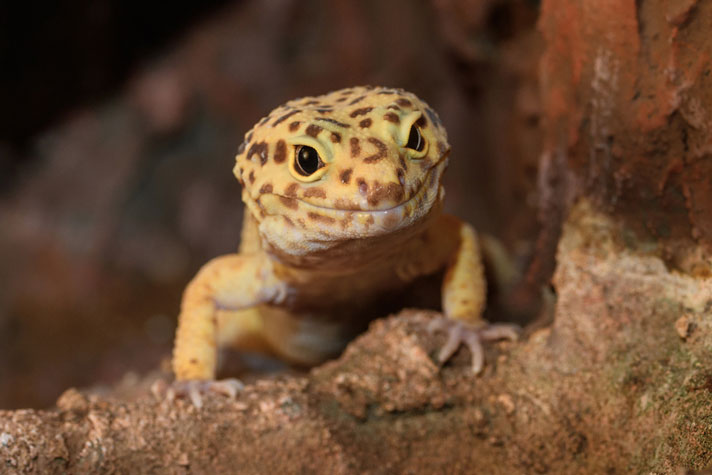
With proper husbandry, The leopard gecko is probably the easiest pet lizard to keep in captivity.
The leopard gecko (Eublepharis macularius) is probably one of the easiest pet lizard to keep in captivity provided you follow their care requirements. No special lighting is required and their diet is fairly simple. You can keep up to two (male and female or two females) in a 10-20 gallon long aquarium with reptile carpet as a substrate. Reptile carpet eliminates any chance of impaction when feeding. I use a covered plastic salad bowl with moistened sphagnum moss as a hide, as well as a paper towel roll. I keep a single heat pad on one side of the enclosure to keep them warm and that is it. No lighting is required as long as you dust the crickets with a calcium supplement. It is recommended that you keep a small container of calcium dust in the enclosure as well as they will lick calcium. I feed mine crickets dusted with calcium and mealworms. I tend to alternate between the two as some times they prefer one over the other.
Leopard geckos come in a variety of morphs and colorations and are widely available. Pricing ranges from $25 to upward of several thousand dollars for a single lizard. It all depends on the rarity of the coloration. One neat aspect of the leopard gecko is the fact that it uses just one corner of the tank as a bathroom. For easy cleanup, I cut out a paper towel into triangle shapes and place these in the corner. Clean up is easy as all the droppings are on the paper towel. Read the Leopard Gecko Care Sheet here.
Crested Gecko
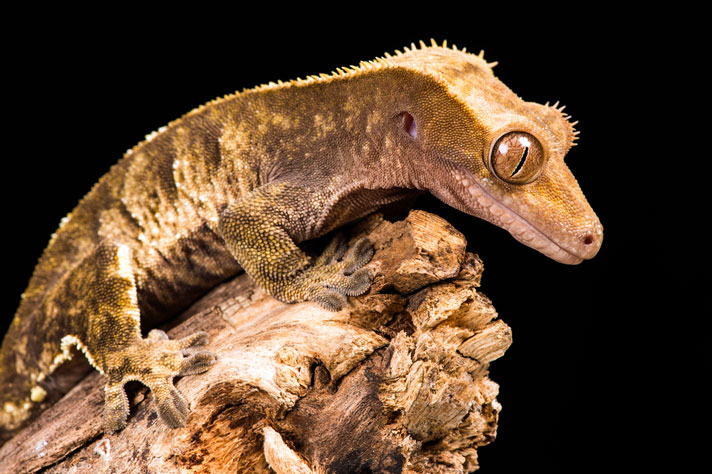
davemhuntphotography/shutterstock
Once a crested gecko drops its tail, it does not grow back.
The crested gecko (Correlophus (Rhacodactylus) ciliatus) makes for an interesting display animal that you can occasionally handle, but remember that if you are rough in the handling department and stress out the gecko, it will drop its tail, and that tail doesn’t grow back. Feeding these guys is fairly straightforward. They are pretty much nectar eaters and there are several commercially prepared crested gecko foods on the market that enable you to easily feed them. You can also feed them crickets that are dusted with a vitamin/mineral supplement, The crested gecko hails from New Caledonia and are widely bred in captivity. They come in a variety of color morphs and their pricing, like the leopard gecko, varies widely depending on commonality or rarity. You can keep a single adult specimen in a 20 gallon tall enclosure with a screen top. You can keep them heated with a low wattage incandescent bulb or a ceramic heat emitter in a reflector type fixture on the screen top. Place some branches or other material under the bulb and this will create a nice basking spot for them. Because they spend most of their time above ground, you can use reptile carpet or a peat-moss-based soil mix as a ground substrate. You can read the Crested Gecko Care Sheet here.
Blue-Tongue Skink
The blue-tongue skink (Tiliqua scincoides intermedia) is probably the most popular of the “larger” lizards in the hobby. Why? For the most part, they are easy to handle and have great personalities. The blue tongue skink hails from Australia and once acclimated, love being handled and even scratched on top of the head or under the chin. They are a terrestrial lizard, so when choosing an enclosure, make sure there is plenty of floor space. Adult blue tongue skinks should be kept in enclosures that are a minimum 3 feet in length by 1.5 feet wide by 10 inches tall.
Heat can be supplied by a heat mat or heat tape and an overhead incandescent basking light or heat emitter. UVB lighting is recommended for eight to 12 hours each day. The blue-tongue skink eats a variety of foods, ranging from canned dog/cat food to hard boiled eggs and cooked ground turkey to fruits and leafy vegetables, squash and carrots. For a full list of recommended foods and how to care for the blue-tongue skink, read the Blue-Tongue Skink Care Sheet.

